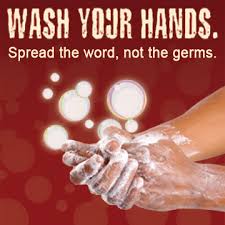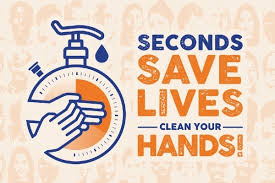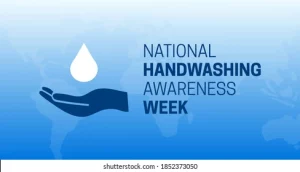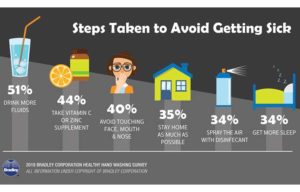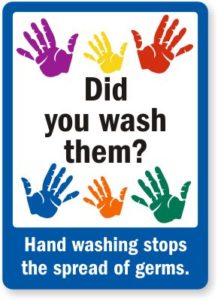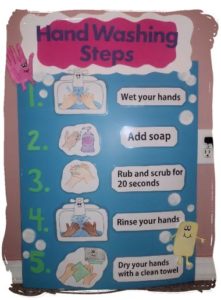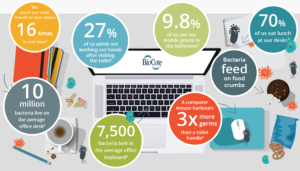THE CDC states:
“Feces (poop) from people or animals is an important source of germs like Salmonella, E. coli O157, and norovirus that cause diarrhea, and it can spread some respiratory infections like adenovirus and hand-foot-mouth disease. These kinds of germs can get onto hands after people use the toilet or change a diaper, but also in less obvious ways, like after handling raw meats that have invisible amounts of animal poop on them. A single gram of human feces—which is about the weight of a paper clip—can contain one trillion germs 1. Germs can also get onto hands if people touch any object that has germs on it because someone coughed or sneezed on it or was touched by some other contaminated object. When these germs get onto hands and are not washed off, they can be passed from person to person and make people sick.
Handwashing with soap removes germs from hands. This helps prevent infections because:
- People frequently touch their eyes, nose, and mouth without even realizing it. Germs can get into the body through the eyes, nose and mouth and make us sick.
- Germs from unwashed hands can get into foods and drinks while people prepare or consume them. Germs can multiply in some types of foods or drinks, under certain conditions, and make people sick.
- Germs from unwashed hands can be transferred to other objects, like handrails, table tops, or toys, and then transferred to another person’s hands.
- Removing germs through handwashing therefore helps prevent diarrhea and respiratory infections and may even help prevent skin and eye infections.
Teaching people about handwashing helps them and their communities stay healthy. Handwashing education in the community:
- Reduces the number of people who get sick with diarrhea by 23-40% 2, 3, 6
- Reduces diarrheal illness in people with weakened immune systems by 58% 4
- Reduces respiratory illnesses, like colds, in the general population by 16-21% 3, 5
- Reduces absenteeism due to gastrointestinal illness in schoolchildren by 29-57% 7
About 1.8 million children under the age of 5 die each year from diarrheal diseases and pneumonia, the top two killers of young children around the
world 8.
- Handwashing with soap could protect about 1 out of every 3 young children who get sick with diarrhea 2, 3 and almost 1 out of 5 young children with respiratory infections like pneumonia 3, 5.
- Although people around the world clean their hands with water, very few use soap to wash their hands. Washing hands with soap removes germs much more effectively 9.
- Handwashing education and access to soap in schools can help improve attendance 10, 11, 12.
- Good handwashing early in life may help improve child development in some settings 13.
- Estimated global rates of handwashing after using the toilet are only 19% 6.
Preventing sickness reduces the amount of antibiotics people use and the likelihood that antibiotic resistance will develop. Handwashing can prevent about 30% of diarrhea-related sicknesses and about 20% of respiratory infections (e.g., colds) 2, 5. Antibiotics often are prescribed unnecessarily for these health issues 14. Reducing the number of these infections by washing hands frequently helps prevent the overuse of antibiotics—the single most important factor leading to antibiotic resistance around the world. Handwashing can also prevent people from getting sick with germs that are already resistant to antibiotics and that can be difficult to treat.”
So what did we learn today WASH OUR HANDS REGULARLY!
